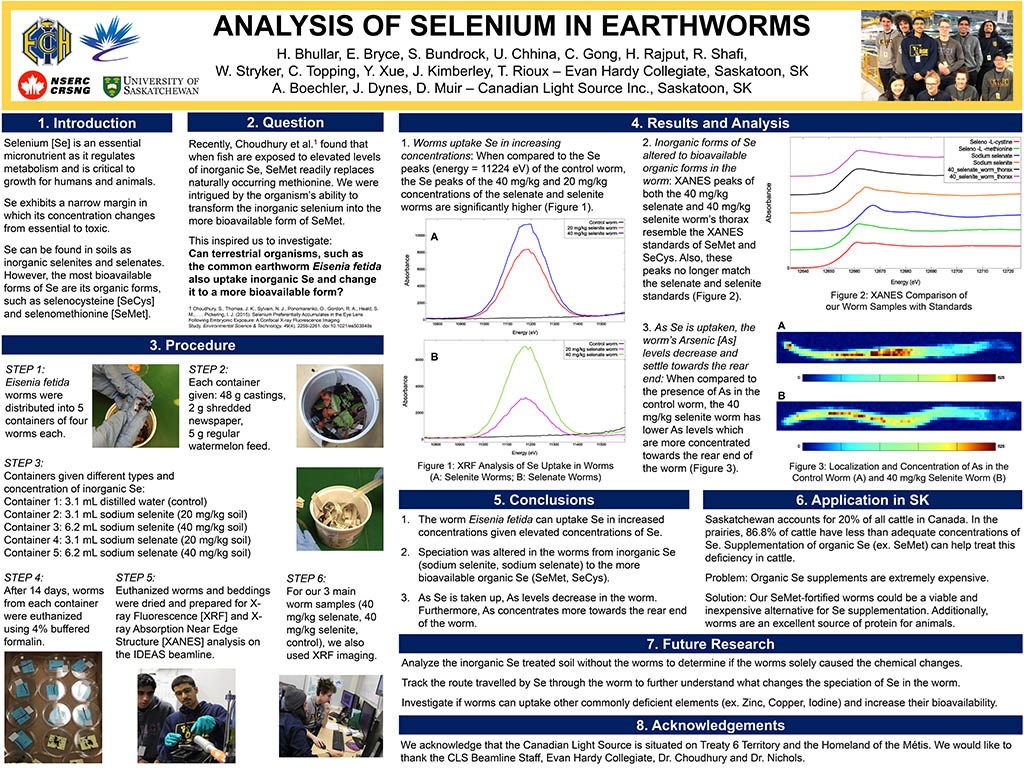
When students from Evan Hardy Collegiate were tasked with investigating a problem that affected Saskatchewan, they turned to the common earthworm to help discover answers.
The resulting scientific poster, Analysis of Selenium in Earthworms, was the winning project in the annual Student on the Beamlines competition held by the Canadian Light Source synchrotron. The work done by students in the school's extracurricular Synchrotron Club was named the top project out of eight posters submitted by high schools from across Canada.
This is the sixth time since 2009 that Evan Hardy has won the poster competition.
"One of the problems we found was Selenium deficiency, especially regarding cattle and poultry. With this as our foundation, we started investigating other papers on the topic," explained the group comprised of students Cathy Gong, Hannah Rajput, Channa Topping, Yiping Xue, William Stryker, Elijah Bruce, Harkirat Bhullar, Uday Chhina, and Rayan Shafi.
"We found a paper written by Dr. (Sanjukta) Choudhury and her team at the University of Saskatchewan on Selenium replacement in aquatic life. They found that selenomethionine readily replaces other methionines especially in the eye. We thought maybe we could replicate this but with a different – land based – organism. We picked the common earthworm since it was easy to raise and could easily be used as samples on the beamline."
Projects for the competition needed to meet criteria including: being relevant to Saskatchewan and the Synchrotron beamline; being able to be completed within a specific time frame; and being safe to work with. After much research the students settled on the project topic in November. Materials were obtained, and the experimental procedure was completed in December. Students were given beam time in late January.
"The type of learning associated with a large project such as this is both exciting and at times frustrating," said teacher Tina Rioux, who serves as the club's adviser along with colleague Jason Kimberley.
"Students spent months researching ideas, discarding ideas and researching more before deciding on a project that interested them, was pertinent to meeting a real-world problem faced in Saskatchewan and needed the CLS to answer. Students had to synthesize a large amount of research and information and call upon scientists to confer."
 Because the club is an extracurricular activity, the bulk of preparation and research were completed during weekly meetings and students also worked during lunch hours and additional weekdays to ensure the project was completed. On the day they had the opportunity to work with the IDEAS beamline at the synchrotron, they spent nine hours at the university, completing various scans, collecting and analyzing their data.
Because the club is an extracurricular activity, the bulk of preparation and research were completed during weekly meetings and students also worked during lunch hours and additional weekdays to ensure the project was completed. On the day they had the opportunity to work with the IDEAS beamline at the synchrotron, they spent nine hours at the university, completing various scans, collecting and analyzing their data.
Students say the Synchrotron Club provides an experience unique from other school activities, particularly the opportunity for extended research on a level normally not explored in the classroom. Working on the beamline provided a unique, hands-on learning opportunity that very few students get to experience. Students prepared samples, loaded the beam, and analyzed results and planned for future experiments.
"As a team, we spent many hours together creating this project, as well as when collecting our data at the Canadian Light Source. This meant our entire team became close which made our success much more rewarding."
The work of the Synchrotron Club was supported by Evan Hardy Collegiate faculty, Dr. Choudhury, Dr. Nichols, Anna-Maria Boechler, David Muir, James Dynes and others who assisted with the completion of the research.